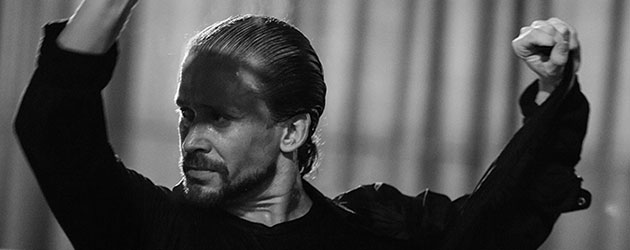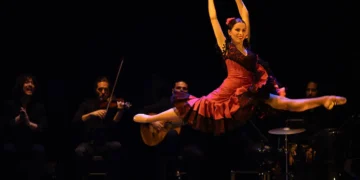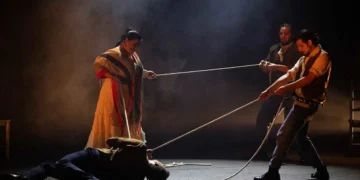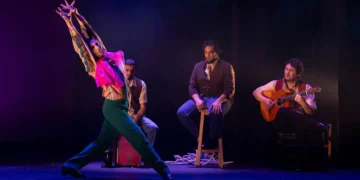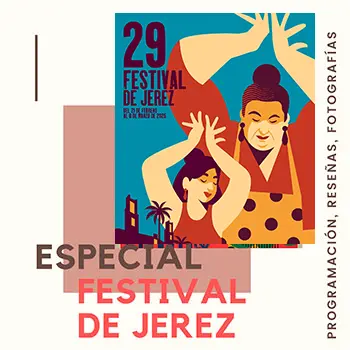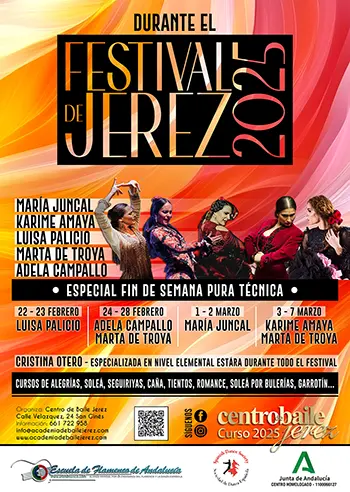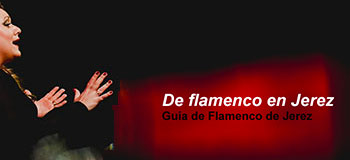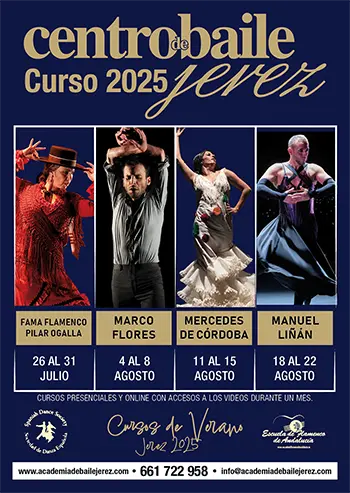Rafael Manjavacas
«Con-secuenciA is a point of departure towards other idioms, to another way of understanding shows»
He’s one of the most recognized and respected individuals of his profession. His dancing has inspired some of the greats (Manuela Carrasco, Farruquito, Morente, Tomatito, Niño Josele, etc.) and has been awarded in such prestigious contests as the Cante de Las Minas, the Nacional of Córdoba and Madrid’s Certamen de Coreografía. Now, in full artistic maturity, and after six works of his own and four more in collaboration with other dancers, Alfonso Losa takes a new step in his career: con-secuenciA will debut March 1st in the 22nd Festival de Jerez.
Interview in video:

Is this your first premiere at the Villamarta Theater?
Yes, it’s the first time at the Villamarta. I debuted two shows at the Sala Compañía, and I’ve been in the Villamarta as guest artist with Gerardo Núñez and others, but with my own production, this is the first time I’ll be able to present my own show at this great theater.
Will we also be able to see it at the Festival Flamenco Madrid?
Yes.
Is this a co-production?
It’s not so much a co-production as a shared undertaking of the two festivals to support this show by various means, and on May 25 we’ll perform it here in Madrid.
You say this show, con-secuenciA, isn’t a conclusion, but a starting-point, and you also claim you want to unlearn in order to grow. Tell us what those concepts mean.
This show reflects the point in time I’m living right now, and it’s a step forward. It’s true that as a dancer, I’m not going to lose my identity in the way I dance, but I’m surrounding myself with a great team, among them, Florencio Campo, who is a great stage director and is helping me to get this work on its feet. With all my years of experience in dance, you might think I already have everything I need to express myself, but it’s exactly the opposite: I need to continue learning, and I can only do that working with people who bring things to me that I don’t know or don’t have. And sometimes, in order to continue learning, I have to question some ideas that I had taken for granted. In order to learn and grow, you have to go back a little, and advance through other doors that someone opens for you. Which is why I talk about unlearning. And as far as the consequence as a starting point, let me explain. I’m looking for a new form of expressing what I feel and not only of dancing flamenco, which is already a very expressive genre, but also having an internal story-line from which I go moving through various motifs. In fact, that’s what the show is about. I use the title as a sort of play on words: I present sequences, and each one of them has a motivation, such as internal rhythm, love, current artists like Rocío Molina, etc. In those acts or sequences, we start out from a motivation, and we don’t know where we’re headed because it’s basically an investigation, it’s an improvisation within a certain order.
And how do you define improvisation?
Improvisation is jumping into the pool at the deep end. It’s true there’s order within a structure, but it means doing what you feel directly. Improvisation is important for me because, in my opinion, it’s what defines the identity of the artist. It’s something so direct, it can’t be defined, it’s your personality.
“In order to learn and to grow you have to go back and advance through other doors that someone opens for you. That’s why I talk about unlearning”
Within that order that also exists in con-secuenciA, what forms do you interpret?
Also in this show, I’ve dared to dance forms I’m not usually accustomed to, and that also makes everything somewhat more risky. I dance romance, alegrías, tientos…styles that aren’t habitual in me. And also the first scene is based on total improvisation: everything is an improvisation that marks the path the show is then going to follow.
But if improvisation is so important, how do you coordinate with the rest of the group?
It’s that within the improvisation, there are always certain norms we all understand, and thanks to which we all end up in the same place, within that freedom. Also, I’m working with very young and free-thinking people who understand flamenco the way I do, like something alive, and they’re artists who enjoy improvising very much.
Tell us about them…
On guitar and in the music composition of the entire work is Yerai Cortés, just 21 years old, but an impressive guitarist. I don’t understand how at that age a person can have that concept of guitar in his head. It’s not normal. He plays like an eighty-year-old man, and at the same time, with the most modern feel you can find today. Also with us are Ismael de la Rosa “El Bola”, Manuel Tañé and La Tana singing, different generations and styles, but three terrific artists. We’ve also got Manu Maseado on percussion who does a great job with the rhythm.
Everyone praises your technique. What is technique for you?
I consider technique a quest. For example, when I see some other dancer do something new, I want to learn it. I love to dance, and, as I said before, I love to learn. If you have that need, you can acquire technique, with great effort of course, but you can acquire it. But for me, it’s mostly a vehicle to be able to dance and to be able to improvise. Technique is very important for me, but not as a goal, but rather because it gives me the tools to be able to better develop my language.
«Con-secuenciA is a point of departure towards other idioms, to another way of understanding shows»
You have stated that in this show, the energy is very important, according to what you say, it goes hand-in-hand with the emotions. What meaning does each have in this work?
In order to dance and to make a show, I need to be artistically moved. If you aren’t moved in every show, this work doesn’t make sense. Which is why for me it’s very important to feel each of the forms, and not only feel what’s inside of me, but also feel what’s inside of each musician. It’s not just a question of singing, playing or dancing in a professional way, but of feeling. In that way energy is created on stage, energy that is different from one moment to the next, in each form. And if we all feel things on stage, if we’re all able to generate that energy, the audience notices that and shares the feeling. That’s what I’m after in each one of the sequences that make up the show.
Rocío Molina accompanies you in con-secuenciA, but in a very special way.
Rocío is a part of my show, and practically of my life. I’ve known her since she was 15, when she came to Madrid. She impressed me from the first moment, she had a penetrating look and I always knew she was going to be big. She never stopped growing. In my show, Rocío represents freedom in dancing, questing, hunger for dance, doing what her instincts tell her. That point of freedom is what she represents better than anyone. And the fact that Rocío is with me is a great support. With the work she has, with all the projects she develops, that she has stopped to carry out this collaboration is very nice. She also represents camaraderie, and that also sends a very nice message, we’re all colleagues and we have to admire one another. Freedom, dance, camaraderie…all those messages are in Rocío Molína’s message.
But she’s not physically present, but rather in an audiovisual, although you interact with her, don’t you…
Yes, it’s an improvisation she recorded, but as far as I’m concerned, she’s present. Just from the emotion I felt when she recorded her piece, for me it’s as if she were by my side. And I think that’s how the audience is going to feel it as well.
In this show you incorporate a facet of your career: stage direction. What does this do for you?
I put my bets on Florencio Campo because he has a great career, and we all feel great admiration for him. We saw him dance, we saw how he makes contact with the stage, how he becomes emotional, we saw him direct… His being part of this is very important for me, mostly in order to have a story line, to know how to be on stage, to be moved with another type of movement that in general we don’t manage. I think that enhances the show greatly. The staging he provided is wonderful. Staging and also personal direction with me.
We know that all performers of flamenco dance, including the most famous, respect you very much and admire you, but your public image is less than some of those artists. Why do you think that is?
Yes, it’s true that steadfastly working this career and flamenco, with affection and seriousness, the time comes when your colleagues value precisely those qualities, that seriousness, that affection, that respect and insistence. And regarding the audience, well, we keep plugging away, always offering better work, being more and better placed, and I truly think I’m really in a very good artistic moment.
And it’s also true that you’ve been a maestro for many of your fellow-dancers, you’ve given classes to a lot of artists who are now touring the world. Does that include Rocío Molina as well?
No, Rocío no.
“To dance farruca well, you have to be dancing farruca ten years”
But she does take a step or two of yours to many of her shows, doesn’t she?
Yes, that’s true. It’s that I really like to create steps, and for many forms. I’ve got lots of material. And I don’t only work with my colleagues giving classes, but collaborating with them, or just hanging out in a studio, giving them whatever I’ve got. Many artists do steps I’ve shared with them, and they use them in their shows. It’s a great satisfaction for me.
In an interview I did with Farruquito, I told him that he was creating a school and that people spoke about a “Farruquero” style, but he said to me: “in reality, it’s me who learns from those people who do that style they call Farruquero”, and he pointed at you.
Well, I think it’s a mistake to pigeon-hole certain artists in a certain style, because each one of us has our own details. You have to be a little more precise and recognize that each artist has his own personality. There’s a big difference between artists who apparently seem to manage the same energy, there are many subtleties that separate one from another. In fact, when there’s admiration between us, it confirms that each one of us has our own personality. We may be joined in a tendency which is a way of managing flamenco, but at the same time it’s also a very open tendency, just as there are other styles of dance that are also similar. But if you analyze it well, each artist has his or her own personality.
Perhaps that tendency to group things together comes from that habit people have of labeling everything. Does it annoy you when people say you have a Farruquero style?
No no, for me, it’s a source of pride. I know who I am, and I know the shading I give, but for me it’s a source of price, as far as I’m concerned, Farruco was a genius. And if anyone thinks I have something similar to that man or that style, it gives me great pride.
“Actually, I dance out of necessity”
Do you see yourself evolving towards idioms such as those of Rocío Molina, Andrés Marín or Israel Galván, to put a few examples?
Why not? I love all that. I go to one of Rocío’s shows and come out of the theater floating on air. That also happens when I see other artists more, shall we say, traditional: I also leave the theater floating on air when I see Manuela Carrasco for example. They’re different languages of dance, and what I love is dance. I went to the conservatory precisely for that reason. Rocío’s path and that of other colleagues is daring, but I like it. In my case, it would have to be little by little, and always in response to my need to express myself, because what I’ll never do is dance something that isn’t me, that doesn’t come out of me, that has no truth for me. But I’d like to, yes. And in fact, this show is a starting point towards other languages, towards another way of understanding shows. Yes, I would like to investigate more in other lines, of course.
You’ve been dancing your entire life. Have you ever stopped to think why you dance?
Yes. I know why I dance. I dance to enjoy myself, but dancing for me is also a personal equilibrium. Dance has been my psychologist. With dancing, I can release everything that’s inside of me and also enjoy everything I have. That’s why I say it’s an equilibrium. If I don’t dance, I’m a worse person. I really dance out of necessity.
In one of Mario Maya’s shows, there was a piece titled “And what I still have to sing”. What do you still have to dance?
Lots of things. Just within standard flamenco, there’s a wide assortment of forms I still haven’t gotten into, and which I’d like to do. I think that dancing one form well, doesn’t happen overnight. To dance farruca well, you have to be dancing farruca ten years. To properly take on a form, I need to understand it well, develop it well, have enough self-confidence to be able to improvise and move freely through that form. That’s in the most flamenco styles, but imagine if I decide to take on other forms. Yes, I’ve got a lot of dancing left in me. I’ve got a whole lifetime to dance.



